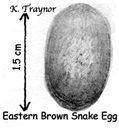During the summer break there have been some interesting snake encounters.
Bill McKellar has given an account of snakes found on their property near Point Addis.
“ We should be used to sharing our area with the fourth and fifth most venomous snakes in the world – the Eastern Brown Snake and the Tiger Snake – as well as the Copperhead, number seven on the venomous list. These three Snakes, as well as most lizards, are viviparous (having live young).
During the last heatwave, both a Tiger snake and a Copperhead were identified at Grasstrees. On the same day, it was startling to find in the potting mix near our shed, 54 live and 60 empty snake eggs. They were about 1.5 cm by 1.0 cm, white, oval, and with a leathery shell.

Inside were embryonic snakes.

Investigation indicated these to be Brown Snake eggs. They are the only egg-laying snake big enough to produce these eggs. Brown Snakes generally lay 15–20 eggs, and sometimes will lay eggs with other Brown Snakes. The staff at the Museum of Victoria were impressed with the high number, as was the local snake catcher. Thus we appear to have 2–3 female Brown Snakes living around our propagating shed, which, so far, has not caused us any grief. At least the Rattus rattus population has disappeared! That’s made an easier life for our tiny plants.
The idea of have 54 or more baby snakes around us was worrying, so the eggs have been relocated to a rabbit burrow a long way from here.”
In a house at Bambra, early in January, the owners watched as a snake moved along the house window ledge and then up and along the window. It spent quite a long time investigating the edges of the window and under the eaves. It was quite probably in search of food. Tiger Snakes often hunt during daylight.
On another occasion, this time at Anglesea, a Tiger Snake was caught in the act of raiding a Blackbird’s nest. The nest was situated about 2 metres above the ground, in an entanglement of Climbing Rose and Wisteria vines. Unfortunately, I suspect the contents of the nest were taken, either eggs or young, as the parent birds have now lost interest in the nest, and don’t attend it at all. Tiger Snakes are very good climbers and have been observed in trees up to 8 metres high.
Kaye Traynor
Community Support the Hooded Plover
The Moggs Creek and extended community have been rallying to support a pair of Hoodies that have been nesting in the Moggs Creek area. Three eggs were discovered on 27 December, in a scrape on the sand just below the dunes. The area was fenced off, and signs put up by a local resident. GORCC later erected more effective signage and fencing, including a small ringlock enclosure that has protected their nest. The king tides in early January were a great threat, but a seaweed barrier put in place by two concerned residents was effective in diverting the water. The birds coped well with the extreme temperatures in mid January, changing their turn on the nest more frequently, and running down to the water’s edge to cool down. They appear to have a very caring partnership. Volunteers and GORCC have been monitoring the nest, and talking to the public about the need to protect this threatened species.
The eggs are due to hatch about 27 January, so by the time you are reading this report, we will know how successful the birds have been. If the chicks hatch, small chick shelters will be placed in the area to offer the Hoodies some protection. This is a critical stage – approx. 35 days – as these little birds have so many predators, including other birds, foxes and dogs. We can only hope that if the eggs hatch, the parents can rear some of their young family.